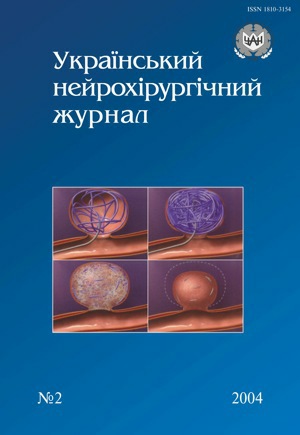Level of 17-ketosteroids, 17-ketogenic steroids and it's ratio in the ingured persons with severe brain trauma depending on its course and treatment
Keywords:
severe traumatic brain injury, hypothalamic-pituitary-adrenal system, stress, adaptation, adrenal glands, corticosteroids, androgens, glucocorticoids, 17 ketosteroidsAbstract
82 paients with severe brain trauma were investigated in acute period of disease. The laboratory tests of 17-ketosteroids and 17-ketogenic steroids levels were carried out in daily urine with next evaluation of their ratio (17-KS/17-KGS). All patients after injury were in coma — (8,1±0,2) points by GCS. Surgical treatment with intracranial hematoma removal permitted the earlier (7–10 day) normalisation of androgenous and glucocorticoidal function of adrenal glands with decrease of 17-KS/17-KGS ratio 30–55 days after injury because of androgenes' deficit and glucocorticoids' spare. In patients with severe brain contusions revealed a glucocorticoids hormon deficit at 7–10 day and later (at 20–30 day) normalization of adrenal cortex function. The features of unfavourable course of injury are excessive oscillations of androgenes, increased level of glucocorticoids and decreased ratio 17-KS/17-KGS in early terms (1–10 day) after trauma.
References
Боева Е.М. Очерки по патофизиологии острой закрытой травмы мозга. – М.: Наука, 1968. — 221 с.
Гельфанд В.Б., Маламуд М.Д., Истратов В.Г. Закрытая черепно-мозговая травма. — Кишинев: Штиинца, 1986. — 278 с.
Гук А. П. Співвідношення метаболітів андрогенів і глюкокортикоїдів у гострому періоді черепно-мозкової травми легкого та середнього ступеня тяжкості: Автореф. дис. … канд. мед. наук: 14.01.05. — Львiв, 1999. — 26с.
Иванов А.И. Гипоталамо-гипофизарные нарушения при тяжелой черепно-мозговой травме: Автореф. дис. ... канд. мед. наук:14.00.28, 14.00.03. — Л., 1987. — 24 с.
Каасик А-Э., Кыйв Л.Е. Паю А.А. и др. Зависимость состояния симпато-адреналовой и гипоталамо-гипофизарно-адренокортикальной систем от тяжести травматического поражения головного мозга // Вопр. нейрохирургии. — 1994. — №1. — С.26.
Коновалов А.H., Коpниенко В.H. Компьютеpная томогpафия в нейpохиpуpгической клинике. — М.: Медицина, 1985. — 293 с.
Куpако Ю.Л., Букина В.В. Легкая закpытая чеpепно-мозговая тpавма. — К.: Здоpовья, 1989. — 160 с.
Лебедев В.В., Быковников Л.Д. Руководство по неотложной нейрохирургии. — М.: Медицина, 1987. — 334 с.
Лихтерман Л.Б. Нейротравматология: Справочник. — М.: Медицина, 1994. — 416 с.
Мамадалиев А.М. Зависимость исходов черепно-мозговой травмы от длительности нарушения сознания // Актуальные вопросы нейротравматологии. — М., 1988. — С.107–111.
Практическая нейрохирургия: Руководство для врачей / Под ред.Б.В. Гайдара. — СПб: Гиппократ, 2002. — 648 с.
Селье Г. Концепция стресса, как мы ее представляем в 1976 году // Новое о гормонах и механизмах их действия. — К., 1977. — С.27–51.
Селье Г. Очерки об адаптационном синдроме: Пер. с англ. — М.: Медгиз, 1960. — 254 с.
Современные представления о патогенезе закрытой черепно-мозговой травмы / И.Г. Васильева, А.Н. Васильев, М.Р. Костюк и др.; Под ред. Е.Г. Педаченко. — К.: ТОВ “Задруга”, 1996. — 282 с.
Харченко В.Г. Прогноз результатів у хворих з важкою поєднаною черепно-мозковою травмою// Актуальні проблеми надання екстреної медичної допомоги при невідкладних станах: Матеріали наук.-практ. конф. — К., 1995. — С.96.
Чабулов А., Амиpханян С.Е. Компьютеpно-томогpафическая семиотика тpавматических диффузных поpажений мозга // Актуальные вопpосы нейpотpавматологии. — М., 1988. — С.128–131.
Chiolero R. Berger M. Endocrine response to brain injury // New Horizons. — 1994. — V.28, N2(4). — P.432–442.
Jeret J.S., Mandell M., Anziska B. et al. Clinical predictors of abnormality disclosed by computed tomography after mild head trauma // Neurosurgery. — 1993. — V.32, N1. — P.9–15.
Koiv L., Merisalu E., Zilmer K. et al. Changes of sympatho-adrenal and hypothalamo-pituitary-adrenocortical system in patients with head injury // Acta Neurol. Scand. — 1997. — V.96, N1. — P.52–58.
Kraus J.F., McArthur D.L. Epidemiologic aspects of brain injury // Neurol Clin. — 1996. — V.14, N2. — P.435–450.
Webster J.B., Bell K.R. Primary adrenal insufficiency following traumatic brain injury:a case report and review of the literature// Arch. Phys. Med. Rehabil. — 1997. — V.78, N3. — P.314–318.
Downloads
How to Cite
Issue
Section
License
Copyright (c) 2004 A. M. Netlukh

This work is licensed under a Creative Commons Attribution 4.0 International License.
Ukrainian Neurosurgical Journal abides by the CREATIVE COMMONS copyright rights and permissions for open access journals.
Authors, who are published in this Journal, agree to the following conditions:
1. The authors reserve the right to authorship of the work and pass the first publication right of this work to the Journal under the terms of Creative Commons Attribution License, which allows others to freely distribute the published research with the obligatory reference to the authors of the original work and the first publication of the work in this Journal.
2. The authors have the right to conclude separate supplement agreements that relate to non-exclusive work distribution in the form of which it has been published by the Journal (for example, to upload the work to the online storage of the Journal or publish it as part of a monograph), provided that the reference to the first publication of the work in this Journal is included.









